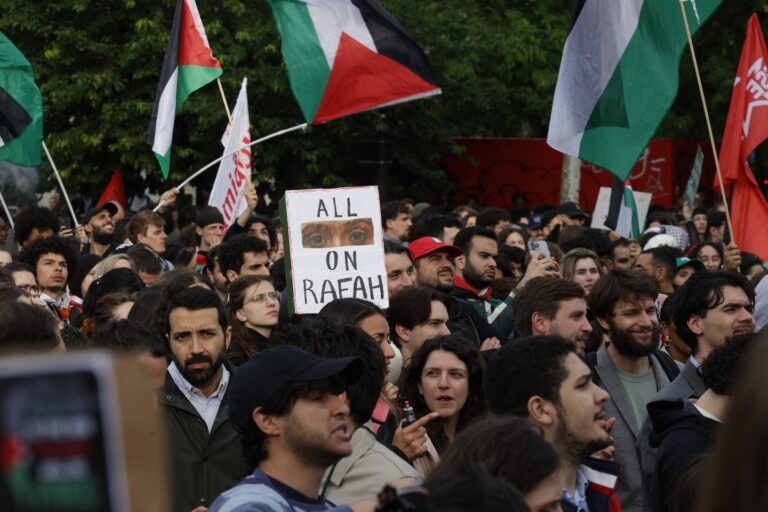Unlike other graphic images of war circulating online, this one was likely generated by artificial intelligence, with some on social media criticizing it as a fake, technologically generated version of real, harrowing footage of what is happening in Gaza (taken by photographers and locals).
Here’s what we know about the image and where the phrase comes from.
What do experts say about the “Focus on Rafa” image?
Felix M. Simon, a communications researcher at the Oxford Internet Institute, said he was “confident” that the image was “generated with the help of AI,” noting that it “shares various visual characteristics typical of AI systems, in particular a certain degree of blurriness.”
In reality, there are no neatly aligned rows of tents or sloping, snow-capped mountains near Rafah’s camp. The tents are set up among fields and buildings, dotted with palm trees and the occasional sand dune. Footage of Sunday night’s deadly attack showed a very different side of Rafah to the images that had gone viral online: red flames tearing fabric, bodies charred beyond recognition, a man holding a headless child.
Simon said that if the photo was genuine, there would likely be other photographs depicting the same scene, given the size and international profile of the camp it depicts.
Get caught up in
Summarised stories to keep you up to date
Instagram said a user named “shahv4012” was the first to use the image in an Instagram Stories template, but the user did not immediately respond to a request for comment from The Washington Post.
Rafah is currently a focal point in the war between Israel and Hamas, and was the last refuge for around one million Palestinians fleeing the fighting. Israel stepped up ground and air operations in the area in early May, leaving displaced people with nowhere to go, activists say. As countries and human rights groups called for an end to the fighting and attacks in Rafah, the IDF expanded its operations this week, pushing deeper into the area considered the heart of Hamas operations, despite an International Court of Justice order for Israel to halt military operations in the area.
Why are people sharing AI-generated images of Rafa?
Many on social media criticised the image as portraying the evacuated areas in an overly optimistic light compared to the actual, graphic footage from the scene, and said its sharing to raise awareness was “performative”.
Social media consultant Matt Navarra said Wednesday that the non-controversial nature of the post may have helped drive the image’s widespread distribution.
“This is not a depiction of real-world violence. It feels sanitized, but it has achieved the level of virality that it has,” Navarra said, adding that Instagram has not yet labeled the image to let users know it was created with AI.
“People want to feel like they can influence those who have the power and authority to make a change,” Navarra says. “When people join a movement, even at the lowest level of involvement, they feel like they’ve contributed something small to a greater cause.”
He added that people may also share the image because it raises awareness of the issue and getting it in media headlines can bring about change.
Cairo-based photographer Sima Ajlyakin shared the photo on her Instagram account but later removed it after questioning what she gained from posting it. She said the image was real and heartbreaking, allowing people outside Gaza to bear witness to what is happening inside.
“At the end of the day, it’s the photojournalists and photographers who are on the ground and reporting on these atrocities, especially those that are being shown to the whole world on social media, that are doing a lot of the alarm,” she said. “They’re the ones who are causing this global outrage. … What does the AI prove?”
She pointed to another widely shared image from Sunday’s attack: a video of a man standing outside a burning tent carrying a headless child by his armpit. Azyulyakin said that one image was particularly impactful, even if it wasn’t shared more widely on social media.
How will social media companies handle AI-generated images?
Earlier this year, Meta, which owns Instagram and Facebook, said it would begin detecting and labeling AI-generated images posted to its platforms. The company said it was working to provide “transparency” in April and planned to start labeling AI-generated content in May. Instagram did not immediately respond to a request for comment on the matter early Wednesday.
Simon noted that while generative AI tools “certainly make it easier” for people online to create bespoke images for specific topics or purposes, traditional tools like Photoshop are also widely used for the same purposes.
Where did the phrase “Pay attention to Rafa” come from?
“All eyes are on Rafah,” Richard Pieperkorn, the World Health Organization’s representative for the West Bank and Gaza, said in February about Israel’s plans for a military invasion of the city. He said an Israeli attack on the city “would result in an immeasurable catastrophe and an unimaginable humanitarian disaster.”
Since then, the slogan has become the slogan of many organizations seeking to raise awareness of living conditions in southern Gaza. Save the Children and Oxfam both use the slogan, while Jewish Voice for Peace message X hours after the strike on Sunday.

